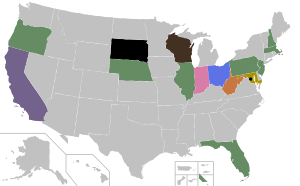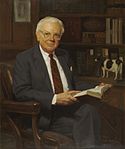Democratic Party presidential primaries, 1964
|
|
||||||||||||||||||||||||||||||||||||||||||||||||||||||||||||||||||||||||||||
|---|---|---|---|---|---|---|---|---|---|---|---|---|---|---|---|---|---|---|---|---|---|---|---|---|---|---|---|---|---|---|---|---|---|---|---|---|---|---|---|---|---|---|---|---|---|---|---|---|---|---|---|---|---|---|---|---|---|---|---|---|---|---|---|---|---|---|---|---|---|---|---|---|---|---|---|---|
|
||||||||||||||||||||||||||||||||||||||||||||||||||||||||||||||||||||||||||||
|
||||||||||||||||||||||||||||||||||||||||||||||||||||||||||||||||||||||||||||

Gold denotes a state won by Daniel Brewster. Purple denotes a state won by Pat Brown. Green denotes a state won by Lyndon B. Johnson. Blue denotes a state won by Albert S. Porter. Orange denotes a state won by Jennings Randolph. Brown denotes a state won by John W. Reynolds. Pink denotes a state won by Matthew E. Welsh. Black denotes a state won by unpledged delegates. Grey denotes a state that did not hold a primary.
|
||||||||||||||||||||||||||||||||||||||||||||||||||||||||||||||||||||||||||||
|
||||||||||||||||||||||||||||||||||||||||||||||||||||||||||||||||||||||||||||
The 1964 Democratic presidential primaries were the selection process by which voters of the Democratic Party chose its nominee for President of the United States in the 1964 U.S. presidential election. Incumbent President Lyndon B. Johnson was selected as the nominee through a series of primary elections and caucuses culminating in the 1964 Democratic National Convention held from August 24 to August 27, 1964, in Atlantic City, New Jersey.
Johnson became President of the United States upon the assassination of John F. Kennedy in 1963, and the goodwill generated by the incident gave him tremendous popularity. In the 1964 presidential primaries for the Democratic Party, Johnson faced no real opposition, yet he insisted until near the time of the Democratic National Convention that he remained undecided about seeking a full term. Johnson's supporters in the sixteen primary states and Washington, D.C. thus ran write-in campaigns or had favorite son candidates run in Johnson's place.
Only two potential candidates threatened Johnson's attempts to unite the party. The first was Governor George C. Wallace of Alabama, who had recently come to prominence with his Stand in the Schoolhouse Door in defiance of the court-ordered desegregation of the University of Alabama. Wallace appeared on the ballot in Wisconsin, Indiana, and Maryland; while he lost all three primaries, he surpassed all expectations, and his performance set the stage for his 1968 third-party run. The other potential contender was Attorney General Robert F. Kennedy, who polls showed was a heavy favorite to be Johnson's running mate. Johnson and Kennedy disliked one another intensely, and although Johnson worried he might need Kennedy to defeat a moderate Republican ticket, he ultimately announced that none of his cabinet members would be selected as his running mate.
...
Wikipedia






